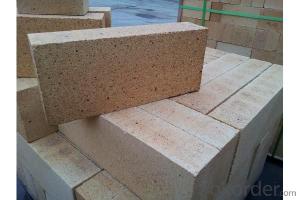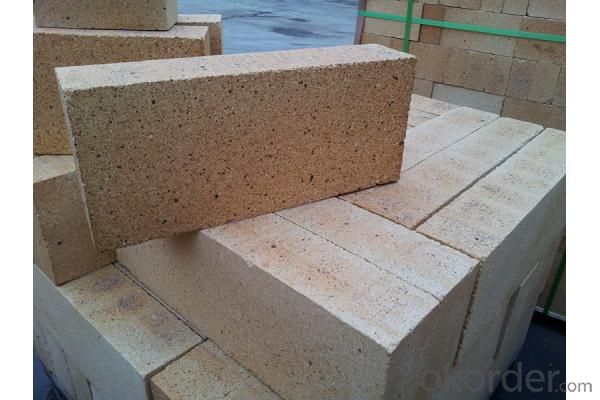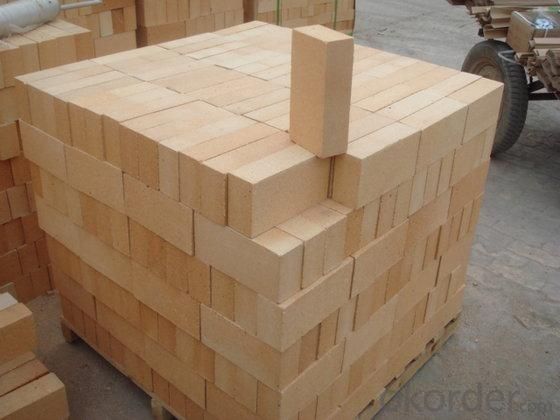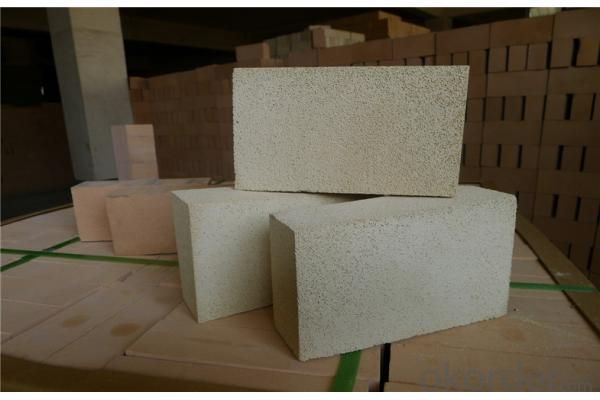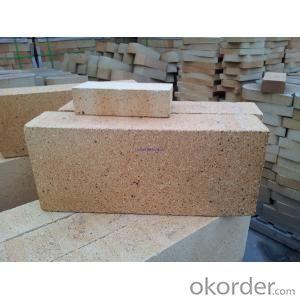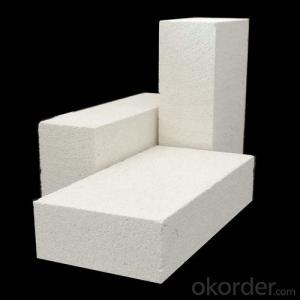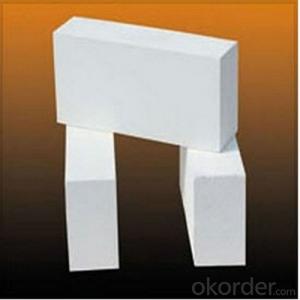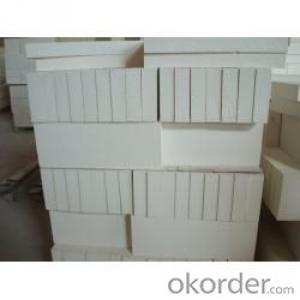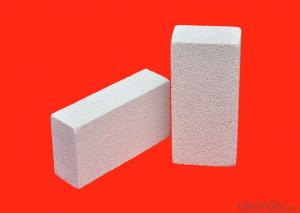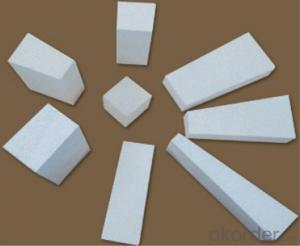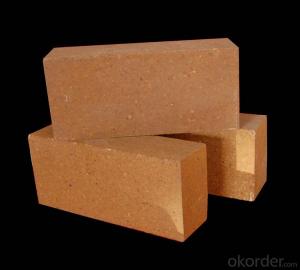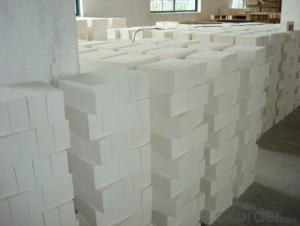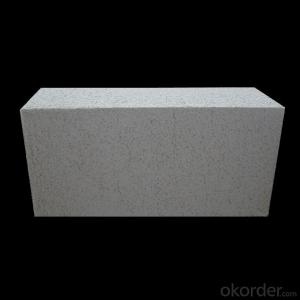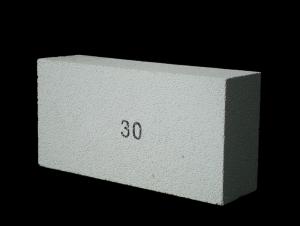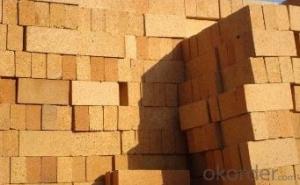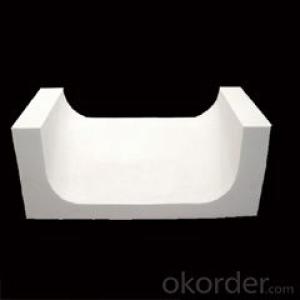Insulating Fire Brick - High Quality Refractory Mullite Insulating Fire Brick
- Loading Port:
- Tianjin
- Payment Terms:
- TT OR LC
- Min Order Qty:
- 10 m.t.
- Supply Capability:
- 10000 m.t./month
OKorder Service Pledge
OKorder Financial Service
You Might Also Like
CNBM conforms strictly to the requirements of ISO 9000 quality control system during the production. MSDS is also available if you want. The thermal insulation fire clay brick meet with the requirements of ASTM & JIS standards. So please stay cool with our quality.
Application
Insulating Fire Brick are used for the lining of converter, alternating current arc furnace, direct Current arc furnace and the ladle slag line, etc.
Insulating Fire Brick Technical index
Brand Quality | JM23 | JM26 | JM28 | JM30 | JM32 | |
Bulk Density (g/cm3) | 0.52 | 0.78 | 0.88 | 1.03 | 1.25 | |
1.2 | 1.6 | 2.1 | 2.5 | 3.5 | ||
Modulus of Rupture (Mpa) | 0.9 | 1.4 | 1.6 | 2.1 | 2.1 | |
-0.5 | 1400℃ -0.4 | 1510℃ -0.5 | 1620℃ -0.9 | 1730℃ -0.9 | ||
Thermal Expansion 1100℃(%) |
0.5 |
0.7 |
0.8 |
0.9 |
1.1 | |
Thermal conductivity(W/m.k)
| 400℃ | 0.14 | 0.27 | 0.32 | 0.41 | 0.49 |
600℃ | 0.16 | 0.29 | 0.34 | 0.43 | 0.50 | |
800℃ | 0.18 | 0.31 | 0.36 | 0.44 | 0.51 | |
1000℃ | 0.20 | 0.33 | 0.38 | 0.45 | 0.53 | |
Al2O3 | 37 | 58 | 67 | 73 | 77 | |
Fe2O3 | 0.7 | 0.7 | 0.6 | 0.5 | 0.4 | |
Equipment
1 unit of Ceramic Abrasive (SG Abrasive) pilot production line
2 units of Compact grain Abrasive pilot production lines
1 unit of high-end coated abrasives (abrasive cloth) production line
2 units of Boron Carbide production lines
3 large flexible crushing and sieving lines for grit production lines
2 units of 2000KVA furnaces for Boron Carbide fusion
6 units of 5000KVA-10000KVA dumping type electric arc furnaces for Brown Fused Alumina fusion
Company Advantage
(1)Long Insulating Fire Brick manufacture history: 25 years manufacturer
(2)Advanced equipment
(3)Diversification of production standards: ISO ANSI FEPA JIS ASTM
(4)Flexible payment: T/T L/C D/P D/A
(5)Professional marketing team and after-sale service
(6)Free sample
FAQs
Q1 |
What’s the transport method? |
A1 | FCL delivery goods with wooden pallet or wooden case by sea; If LCL delivery, must with wooden case; Sometimes need open top, flat rack or bulk cargo. |
Q2 |
What’s the required payment term? |
A2 | Generally 30% TT as the prepayment, 70% TT before delivery. If need, 100% Irrevocable Letter of Credit or negotiation. |
Q3 |
Which country are our products exported to? |
A3 | Apart from entire Chinese market, the US, Russia, Japan, Korea, Australia and some Southeast Asian Nations. |
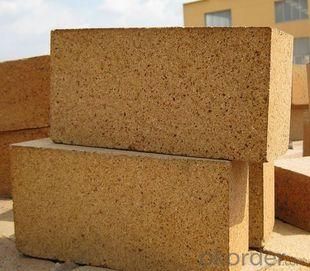
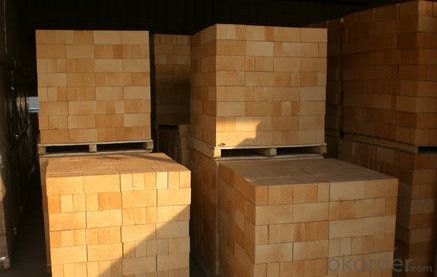
- Q: Are insulating fire bricks resistant to sulfates?
- Insulating fire bricks are generally resistant to sulfates. These bricks are made of high-alumina or silica materials, which have good chemical resistance properties. Sulfates are a type of chemical compound that can react with certain materials and cause degradation. However, insulating fire bricks are designed to withstand high temperatures and harsh chemical environments, including exposure to sulfates. They are often used in applications such as furnaces, kilns, and incinerators where they may come into contact with sulfates. Nevertheless, it is important to consider the specific composition and quality of the insulating fire bricks, as well as the concentration and duration of sulfate exposure, to ensure their long-term performance and durability.
- Q: Can insulating fire bricks be used as a backup insulation in refractory linings?
- Yes, insulating fire bricks can be used as a backup insulation in refractory linings. Insulating fire bricks are designed to have low thermal conductivity, which makes them effective in reducing heat transfer in high-temperature applications. Their insulating properties make them ideal for use as a backup insulation layer in refractory linings, helping to further reduce heat loss and improve overall energy efficiency. Additionally, insulating fire bricks are lightweight, which makes them easier to handle and install compared to other refractory materials. However, it is important to consider the specific requirements of the application and consult with a refractory engineer to ensure that insulating fire bricks are suitable for the specific conditions and performance requirements of the refractory lining.
- Q: Can insulating fire bricks be used in outdoor fire pits?
- Yes, insulating fire bricks can be used in outdoor fire pits. Insulating fire bricks are designed to withstand high temperatures, making them suitable for use in fire pits. They are made from materials that are resistant to heat, such as ceramic fibers or refractory materials, which helps to retain the heat within the fire pit. Additionally, insulating fire bricks are lightweight and easy to install, making them a convenient choice for outdoor fire pits. However, it is important to note that insulating fire bricks may not be as durable as regular fire bricks, so they may require more frequent replacement if exposed to extreme temperatures or harsh weather conditions.
- Q: Are insulating fire bricks suitable for insulation in walls?
- Insulating fire bricks are not typically suitable for insulation in walls. While they are excellent for high-temperature applications, such as lining furnaces or kilns, they have limited insulation properties when it comes to walls. Insulating fire bricks have lower thermal conductivity than regular bricks, meaning they conduct heat at a slower rate. However, they are not as effective as other insulation materials specifically designed for walls, such as fiberglass, foam boards, or mineral wool. These materials are specifically engineered to provide superior insulation properties, such as higher R-values, which measure the material's resistance to heat transfer. Additionally, insulating fire bricks are often more expensive and heavier than other insulation options, making them less practical for wall insulation. Therefore, while insulating fire bricks have their advantages in certain applications, they are generally not the best choice for insulating walls.
- Q: Can insulating fire bricks be used in chimneys and flues?
- Insulating fire bricks are designed specifically for high-temperature usage and are commonly employed in industrial settings, furnaces, and kilns. While they possess exceptional insulating properties, they may not be the optimal choice for chimneys and flues in residential or commercial buildings. The primary reason for this is that insulating fire bricks lack the durability and heat resistance found in other materials specifically designed for chimney and flue construction. They have the potential to crack or break when subjected to the extreme heat and rapid temperature fluctuations that occur in chimneys. Moreover, these bricks are not typically engineered to withstand the corrosive effects of flue gases, which can result in their degradation over time. When dealing with chimneys and flues, it is generally recommended to utilize materials like clay flue liners, stainless steel, or refractory bricks that are specifically manufactured for these purposes. These materials are better equipped to handle the elevated temperatures, corrosive gases, and rapid thermal expansion and contraction that are inherent to chimneys. It is crucial to consult a professional chimney or flue specialist who can provide guidance on the suitable materials to employ based on the specific requirements and conditions of your chimney or flue system.
- Q: How do insulating fire bricks help improve the efficiency of heat recovery systems?
- Insulating fire bricks are essential for improving the efficiency of heat recovery systems in multiple ways. To begin with, these bricks are crafted from top-notch insulating materials like ceramic fiber, which possess exceptional thermal properties. This implies that they exhibit a low thermal conductivity, thus preventing the escape or wastage of heat. By incorporating insulating fire bricks as lining materials in heat recovery systems, the heat exchange process becomes more efficient as less heat is lost to the surroundings. Furthermore, insulating fire bricks aid in reducing heat transfer through conduction. They serve as a barrier between the hot and cold sides of the system, thereby minimizing heat loss through direct contact. This insulation effect enables the heat recovery system to maintain a higher temperature on the hot side, maximizing the temperature difference and ultimately enhancing the rate of heat transfer. In addition, these fire bricks are lightweight and possess low heat storage capabilities. Consequently, they require less energy for heating and cooling, resulting in faster response times for the heat recovery system. This quick response enables the system to adapt swiftly to changes in heat generation or demand, thereby improving its overall efficiency. Moreover, the utilization of insulating fire bricks as refractory materials in heat recovery systems aids in reducing energy consumption. Since these bricks can withstand high temperatures without cracking or deforming, they contribute to the system's longevity, reducing the need for frequent repairs or replacements. This leads to lower maintenance costs and less downtime, ultimately enhancing the overall energy efficiency of the heat recovery system. To summarize, insulating fire bricks bolster the efficiency of heat recovery systems by providing superb thermal insulation, minimizing heat loss through conduction, enabling rapid response times, and reducing energy consumption. Their incorporation as lining materials significantly enhances the heat transfer process, resulting in more effective heat recovery and utilization.
- Q: Are insulating fire bricks suitable for insulation in cryogenic applications?
- Insulating fire bricks are indeed appropriate for insulation in cryogenic applications. These bricks are crafted from lightweight refractory materials that possess exceptional thermal insulation qualities. With their low thermal conductivity, high melting points, and ability to withstand extremely frigid temperatures, they are perfectly suited for cryogenic applications. Cryogenic applications entail the handling and storage of materials at exceedingly low temperatures, typically below -150 degrees Celsius (-238 degrees Fahrenheit). Insulating fire bricks are specifically designed to provide efficient insulation in such extreme conditions, effectively preventing heat transfer and maintaining the desired low temperature. Moreover, insulating fire bricks exhibit chemical stability and possess excellent resistance to thermal shock. This means they can endure rapid temperature fluctuations without cracking or deteriorating, which is particularly crucial in cryogenic applications where such variations are commonplace. In addition to their exceptional thermal insulation qualities, insulating fire bricks are lightweight and easy to handle, making them convenient for installation in cryogenic systems. All in all, insulating fire bricks are a suitable choice for insulation in cryogenic applications due to their thermal insulation properties, resistance to high temperatures, chemical stability, and ability to withstand thermal shock.
- Q: Can insulating fire bricks be used in electric furnaces?
- Yes, insulating fire bricks can be used in electric furnaces. These bricks are specifically designed to withstand high temperatures and provide excellent insulation, making them suitable for use in electric furnaces where heat retention is crucial.
- Q: Can insulating fire bricks be used in the construction of thermal insulation roofs?
- Yes, insulating fire bricks can be used in the construction of thermal insulation roofs. Insulating fire bricks are specially designed to have high thermal insulation properties, making them an ideal choice for applications that require heat retention and energy efficiency. These bricks are made from lightweight materials such as clay, which have low thermal conductivity and high resistance to heat transfer. This allows them to effectively reduce heat loss or gain, making them suitable for use in thermal insulation roofs. Additionally, insulating fire bricks are durable and can withstand high temperatures, making them a reliable choice for long-term use in roofing applications.
- Q: Can insulating fire bricks be used in paper mills?
- Insulating fire bricks are indeed applicable for use in paper mills. They are widely employed in various industries that necessitate effective insulation against elevated temperatures, including steel, glass, and ceramics. Within paper mills, where activities like drying, heating, and burning take place, insulating fire bricks offer an ideal solution for lining kilns, furnaces, and other equipment. Their exceptional thermal insulation properties and ability to withstand extreme temperatures render them highly suitable for deployment in paper mills, where heat plays an indispensable role in the manufacturing process. Furthermore, these bricks possess the advantages of being lightweight and exhibiting low thermal conductivity, enabling efficient heat retention and yielding energy savings.
Send your message to us
Insulating Fire Brick - High Quality Refractory Mullite Insulating Fire Brick
- Loading Port:
- Tianjin
- Payment Terms:
- TT OR LC
- Min Order Qty:
- 10 m.t.
- Supply Capability:
- 10000 m.t./month
OKorder Service Pledge
OKorder Financial Service
Similar products
Hot products
Hot Searches
Related keywords
